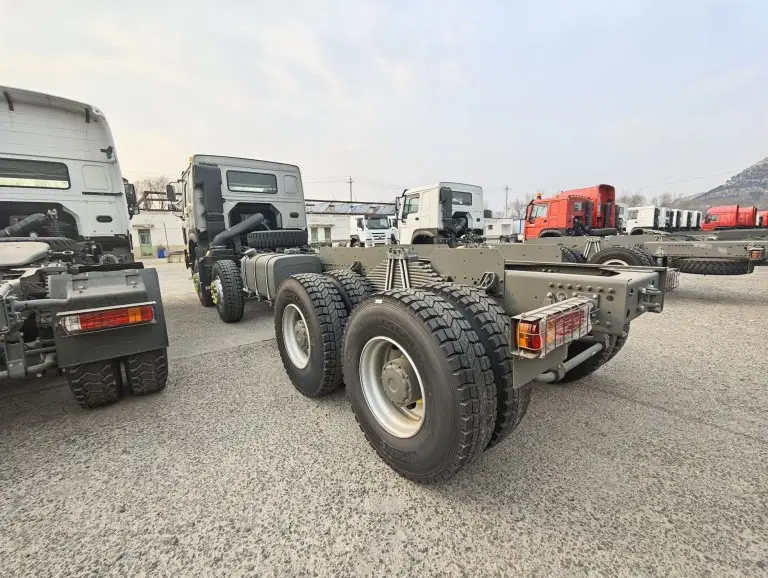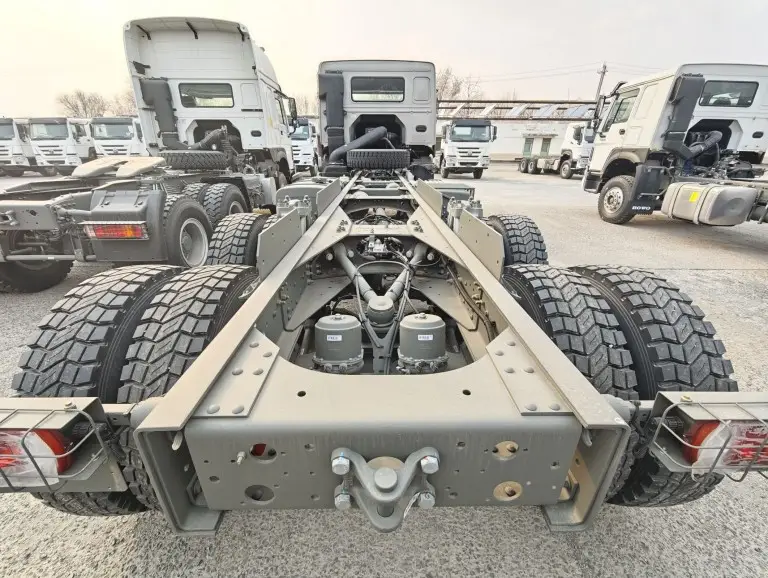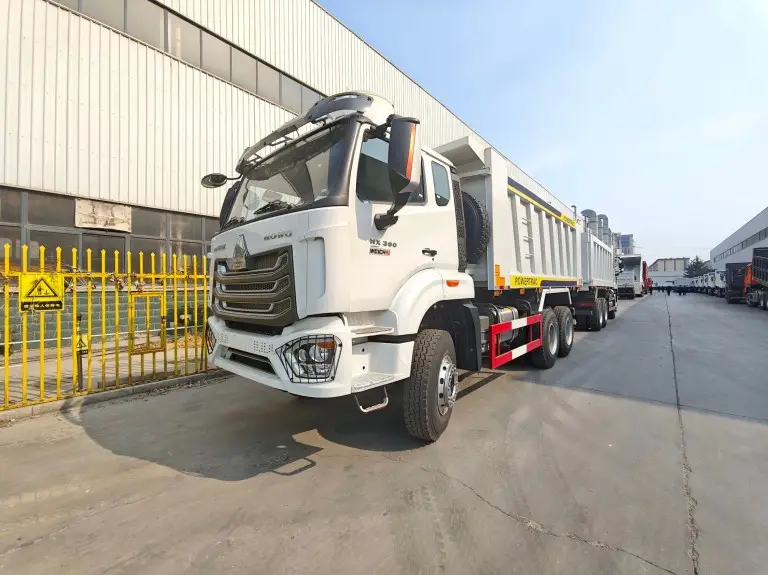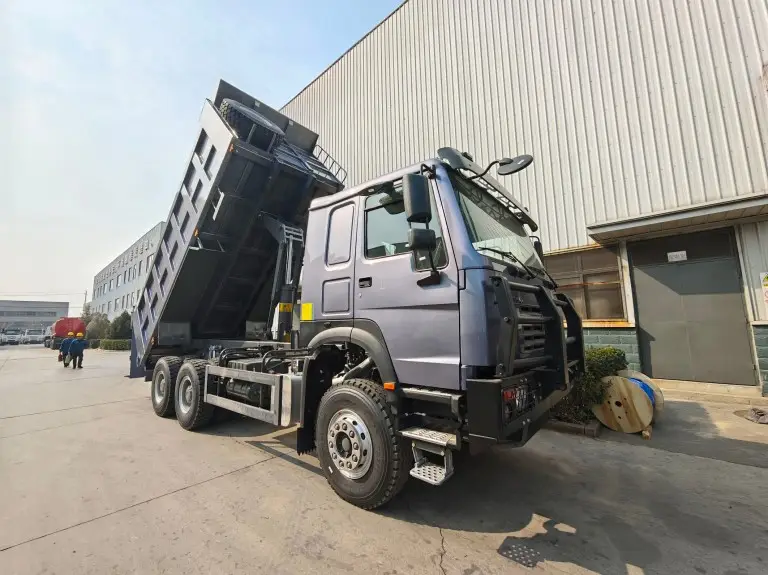Genron understands the importance of advanced safety features in heavy-duty vehicles. HOWO trucks, manufactured by China National Heavy Duty Truck Group (Sinotruk), are known for their reliable quality and strong performance. SINO HOWO trucks feature advanced braking technology, using a dual-circuit compressed air braking system. This system ensures reliable stopping power, even in tough conditions. It enhances driver safety and cargo security, making HOWO trucks ideal for various commercial uses. Understanding the braking system is key to maximizing safety, efficiency, and durability. This article explores its components, advanced technologies, performance in different conditions, and maintenance tips to help you make informed decisions.
Table of Contents
Braking System of HOWO Trucks
A reliable braking system is essential for heavy-duty trucks like HOWO, often used for long-haul transport, container shipping, and hazardous goods. Stopping a fully loaded truck requires advanced braking technology to handle momentum and weight distribution. A good braking system directly impacts driver safety, cargo security, and operational efficiency. At Genron, we customize HOWO trucks with braking systems tailored to specific needs, ensuring top performance across applications. We prioritize safety and performance by adopting advanced braking technologies.

Main Braking System Components of HOWO Trucks
The safety of HOWO trucks relies on a sophisticated braking system with several key components. Sinotruk designed this system with safety and reliability in mind, using a dual-circuit compressed air braking system. This advanced system enhances control and stability, even during heavy braking. It also provides a backup, ensuring the brakes work even if one circuit fails.
Dual-Circuit Compressed Air Braking System
The dual-circuit compressed air braking system is the backbone of HOWO truck safety. It ensures braking capability even if one circuit fails. This system uses compressed air to power the brakes, making it adaptable to the heavy loads of these trucks. It handles the braking force needed for high-tonnage transport. Compared to other systems, it performs exceptionally well in heavy-duty operations, reducing the risk of overheating or failure. According to Sinotruk, this system meets dual-circuit air braking standards and can handle loads up to 40 tons.
- Provides backup in case of circuit failure
- Uses compressed air to transmit braking force
- Responds faster than hydraulic systems
- Reduces the risk of brake fade
Service Braking Mechanism
The service braking mechanism works through the interaction of the brake pedal, air pressure system, and braking components at each wheel. Depending on the model, it uses either drum brakes (with brake shoes) or disc brakes (with calipers and pads). When the driver presses the brake pedal, the air pressure system activates the brakes at each wheel. This ensures effective stopping, even under heavy loads. Road tests show this mechanism can reduce stopping distances by 10-15%.
Parking and Emergency Braking Functions
HOWO trucks have a strong parking brake system that works independently of the service brakes. It uses spring energy to lock the rear wheels securely, even on slopes. The emergency brake adds another layer of safety, engaging automatically if air pressure drops below a safe level. The parking brake keeps the truck stationary on inclines, while the emergency brake ensures safety during system failures.
These components work together to provide reliable stopping power in various conditions. Understanding their functions highlights the complexity and sophistication of HOWO truck braking systems. This design not only improves safety but also reduces maintenance costs over time.
Advanced Anti-Lock Braking System (ABS) Technology in HOWO Trucks
The advanced anti-lock braking system (ABS) is a key safety feature in HOWO trucks. It enhances stability during emergency braking by preventing wheel lockup. This system maintains steering control and stability.
The ABS uses wheel speed sensors, electronic control units, and modulator valves to prevent wheel lockup. It rapidly adjusts brake pressure—up to 15 times per second—allowing tires to maintain traction while applying maximum braking force. This is crucial in emergencies, ensuring vehicle control. Sinotruk offers ABS in 4-channel or 6-channel configurations.
For heavy loads, ABS provides several benefits:
- Shorter stopping distances on slippery roads
- Maintained steering control during emergency braking
- Reduced tire wear by preventing skidding
ABS integrates seamlessly with other safety systems like Electronic Stability Control (ESC) and Traction Control System (TCS). Together, these systems create a safety network that prevents accidents and maintains control in tough conditions. For example, ESC reduces rollover risks, while TCS improves grip on slippery surfaces. This multi-layered protection enhances safety and reliability, especially in dump truck models.
Electronic Braking System (EBS) in HOWO Trucks
The Electronic Braking System (EBS) is a major advancement in HOWO trucks. It improves braking response and efficiency by electronically controlling braking force distribution.
EBS includes electronic control units, pressure modulators, and wheel speed sensors. These components work together through the vehicle’s CAN bus network to optimize braking performance. By using electronic signals instead of pneumatic controls, EBS outperforms traditional air braking systems.
| Component | Function |
|---|---|
| Electronic Control Unit | Processes sensor data to control braking force |
| Pressure Modulator | Regulates air pressure for optimal braking |
| Wheel Speed Sensor | Monitors wheel speed to prevent lockup |
EBS reacts up to three times faster than traditional systems. It distributes braking pressure precisely across all wheels based on real-time load conditions. Benefits include shorter stopping distances, better stability, and increased driver confidence. EBS also reduces air consumption, brake wear, and improves overall control, ensuring safer operations.
Auxiliary Braking System in HOWO Trucks
Some HOWO models include auxiliary braking systems for added durability and control. These systems are especially useful for heavy-duty or downhill operations, reducing strain on the main brakes. Sinotruk designed these features to extend component life and improve efficiency.
Water Auxiliary Brake
Heavy-duty models like the HOWO Max series often use water auxiliary brakes, also called hydraulic retarders. These create resistance through water to decelerate the truck smoothly. This is ideal for long-distance or downhill driving. It significantly reduces wear on traditional brakes, ensuring reliability under intense use.
Exhaust Auxiliary Braking
Some models also feature exhaust auxiliary braking. This system creates back pressure by adjusting the engine’s exhaust path, slowing the vehicle gradually. It’s particularly useful for frequent start-stop conditions, providing engine-assisted speed control without relying on the main brakes.
Maintenance and Care of HOWO Truck Braking Systems
To ensure safety and performance, regular maintenance of HOWO truck braking systems is essential. Following a strict schedule reduces the risk of failures and extends component life.
Regular Inspection and Maintenance Schedule: A detailed maintenance schedule is critical for safe operation.
| Inspection Frequency | Components to Check |
|---|---|
| Daily | Brake pad thickness, brake shoes |
| Weekly | Brake calipers, air pressure |
| Monthly | Brake fluid levels, air lines |
Common Braking Issues and Troubleshooting: Common issues include air leaks, uneven brake pad wear, brake fade, and pedal problems. Troubleshooting involves checking air lines for leaks, replacing worn pads, maintaining fluid levels, and inspecting the brake pedal.
Professional Service Recommendations: We recommend certified technicians for servicing HOWO truck brakes. Using genuine parts ensures compliance with manufacturer standards, extending lifespan and meeting safety regulations.
Conclusion
HOWO trucks feature advanced braking systems designed for safety and control. From the dual-circuit compressed air system to ABS and EBS, these technologies ensure reliable performance in all conditions. Regular maintenance is key to keeping these systems in top shape. By following proper schedules and using advanced technologies, HOWO truck owners can ensure safety, efficiency, and durability. For more information or customization options, contact the Genron team. We’re here to help you find the perfect truck and braking system for your needs.
FAQ
What type of braking system is used in HOWO trucks?
HOWO trucks use a dual-circuit compressed air braking system for reliable performance.
How does the Anti-Lock Braking System (ABS) work in HOWO trucks?
ABS prevents wheel lockup during hard braking, ensuring stable and controlled stops.
What are the benefits of the Electronic Braking System (EBS)?
EBS improves braking response, stability, and control, especially with heavy loads.
How do I maintain the braking system of my HOWO truck?
Regularly check brake pads, shoes, and fluid levels. Address issues promptly.
Can HOWO trucks handle heavy loads and rough terrain?
Yes, they are designed for heavy loads and tough conditions, with advanced braking systems for safety.
What should I do if I experience braking issues?
Consult a professional mechanic or authorized service center for diagnosis and repair.





